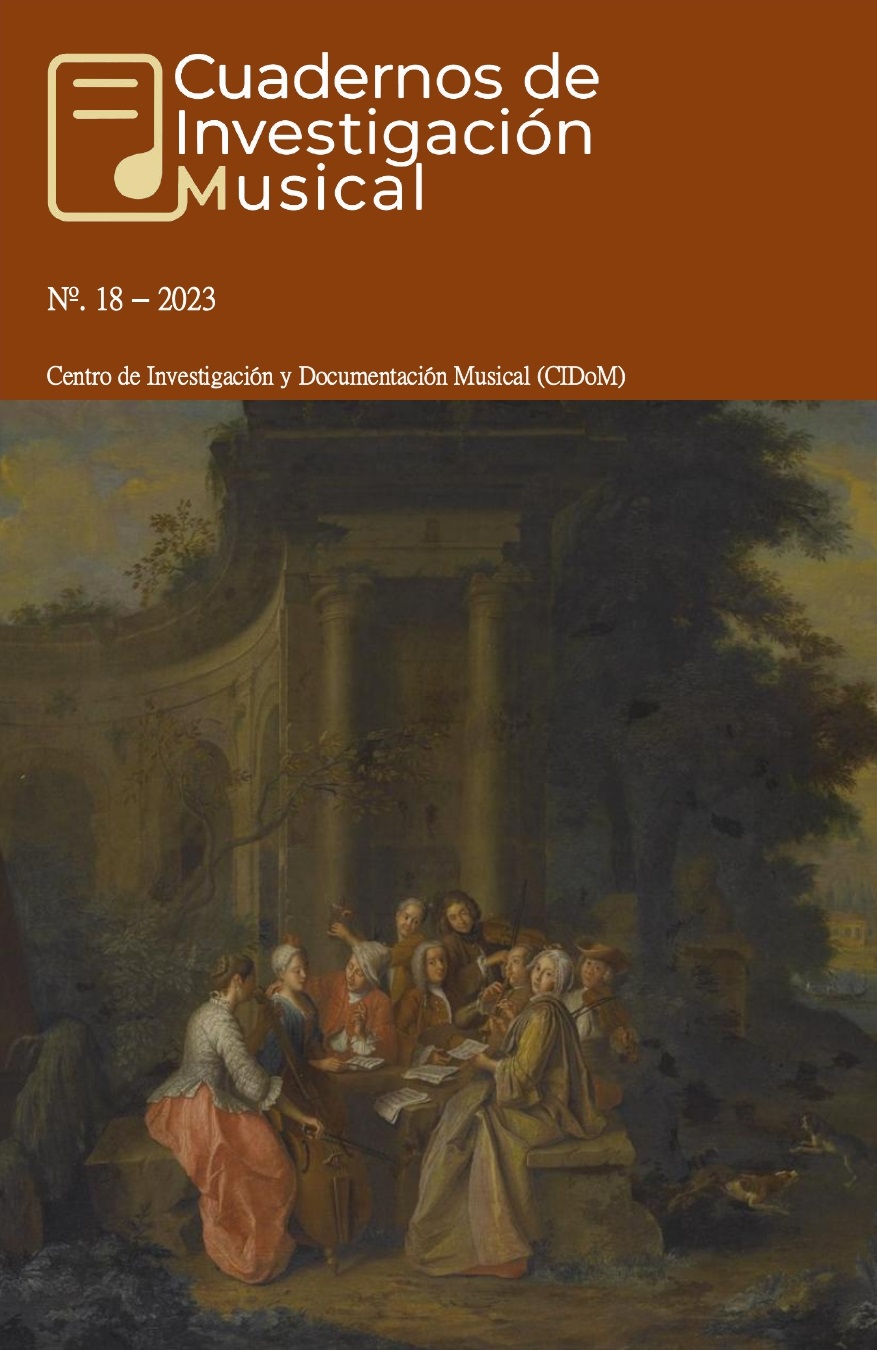Why do baddies prefer classical music? Refined perversion and musical canon in cinema
Main Article Content
Abstract
Movies contain a long record of villains who have expressed their predilection for 19th Century European musical canon. We will ask ourselves when and why this trend is observed, trying to trace some of the steps that “classical music” has taken to end up being the favorite of the baddies. We will also look for possible interpretations and meanings that this repertoire acquires when it is removed from its context and linked to these characters.
Article Details

This work is licensed under a Creative Commons Attribution-NonCommercial-NoDerivatives 4.0 International License.
Los autores de los artículos mantienen el copyright, no recibirán ninguna contraprestación económica por el trabajo y el mismo siempre será reconocido como exclusivamente suyo. La revista se compromete a proteger la integridad y originalidad del artículo, así como los derechos de autor que correspondan. Los autores son los únicos responsables del material, textos e imágenes que utilizan en sus respectivos trabajos, debiendo respetar siempre los derechos de autor de terceras personas, por lo que la revista no se hace responsable de lo contenido en este tema respecto al trabajo de los autores.
References
Beuchot, M. (2015). Elementos esenciales de una hermenéutica analógica. Diánoia, Vol. 60, nº 74. http://www.scielo.org.mx/pdf/dianoia/v60n74/v60n74a6.pdf [Consulta: 31 de enero de 2023].
Brook, V. (2009). Driven to Darkness: Jewish Émigré Directors and the Rise of Film Noir. New Jersey: Rutgers University Press.
Brown, R. S. (1994). Overtones and Undertones: Reading Film Music. University of California Press.
Burke, P. (2003). Formas de hacer historia. Madrid: Alianza Editorial.
Buhler, J. (2014). Ontological, Formal, and Critical Theories of Film Music and Sound. En D. Neumeyer (Ed.) The Oxford Handbook of Film Music Studies (pp. 188-225). Nueva York: Oxford University Press.
Citron, M. (2014). Opera and Film. En D. Neumeyer (Ed.) The Oxford Handbook of Film Music Studies (pp. 44-71). Nueva York: Oxford University Press.
Cooke, M. (2008). A History of Film Music. Nueva York: Cambridge University Press.
Cormack, M. (2006). The Pleasures of Ambiguity: Using Classical Music in Film. En P. Powrie (Ed.). Changing Tunes: The Use of Pre- existing Music in Film (pp. 19- 30), Burlington: Ashgate
Doyle, A. C. (1975 [1892]). The complete adventures and memoirs of Sherlock Holmes: a facsímile of the original Strand magazine stories, 1891-1893. New York: C. N. Porter.
Fleming, I. (2012 [1962]). The Spy Who Loved Me. Las Vegas: Thomas & Mercer Edition.
Fraile Prieto, T. (2004). Funciones de la música en el cine. https://musicaudiovisual.files.wordpress.com/2011/10/funciones-de-la-mc3basica-en-el-cine-teresa-fraile1.pdf [Consulta: 31 de enero de 2023]
Franke, L. (2006). The Godfather Part III: Film, Opera and the Generation of Meaning. En P. Powrie (Ed.). Changing Tunes: The Use of Pre- existing Music in Film (pp. 31-46), Burlington: Ashgate.
Gadamer, H.G. (1997). La hermenéutica de la sospecha. En G. Aranzueque (Ed.) Horizontes del relato: lecturas y conversaciones con Paul Ricoeur (pp. 127-1 36). Madrid: Vicedecanato de la Facultad de Filosofía y Letras de la UAM. https://repositorio.uam.es/handle/10486/297 [Consulta: 31 de enero de 2023].
García Martín, J. H. (2009). What a Wonderful World o la construcción de mundos simbólicos. En M. Olarte (Ed.) Reflexiones en torno a la música y la imagen desde la musicología española (pp. 903-920). Salamanca: Plaza Universitaria Ediciones.
García Martín, J. H. (2018). La musicalización diegética de la crisis en el cine negro holliwodiense de los años 40. La música clásica como signo del conflicto. Área Abierta. Revista de comunicación audiovisual y publicitaria. 18 (3), pp. 389-407. https://revistas.ucm.es/index.php/ARAB/article/view/58492/4564456548454 [Consulta: 31 de enero de 2023].
Halfyard, J. K. (2006). Screen playing: cinematic representations of classical music performance and European identity. En M. Mera y D. Burnand (Eds.) European Film Music (pp. 73-85). London and Burlington: Ashgate Publications.
Horowitz, J. (2008). Artists in Exile. How refugees from twentieth-Century War and Revolution transformed the American Performing Arts. New York: Harper.
Keneally, T. (1995 [1982]). El arca de Schindler. Barcelona: Salvat.
King, S. (2016). Different Seasons. New York: Scribner.
King, S. (2017 [1987]). Misery. New York: Pocket Books.
Kramer, L. (2014). Classical Music, Virtual Bodies, Narrative Film. En D. Neumeyer (Ed.) The Oxford Handbook of Film Music Studies (pp. 351-365). Nueva York: Oxford University Press.
López Alcaraz, J. (2001). Tristán e Iseo. Imágenes modernas de una leyenda medieval. Estudios Románicos, 13-14, pp. 127-154.
Mateos Hernández, L.A. (2011). Fundamentos de Musicoterapia. En L. A. Mateos (Ed.) Terapias artístico creativas (pp. 105-144). Salamanca: Amarú Ediciones.
Miklitsch, R. (2011). Siren City: Sound and Source Music in Classic American Noir. New Jersey: Rutgers University Press. Versión Ebook.
Montoya Rubio, J. C. (2016). Clásicos populares gracias al cine. La banda sonora como agente generador de significados musicales. En S. de Andrés Bailón (ed.) Estudios sobre la canción popular en el proceso de creación de música incidental (pp. 321-334) Salamanca: Ediciones Universidad de Salamanca.
Radigales, J. (2005). Usos y abusos de la música “clásica” en el cine. Estudio de casos. En M. Olarte (Ed.) La música en los medios audiovisuales (pp. 13-32). Salamanca: Plaza Universitaria Ediciones.
Randel, D. (1999). Diccionario Harvard de Música. Madrid, Alianza Editorial.
Rice, Anne. 2014. Interview with the Vampire. New York: Ballantine Books.
Spring, K. (2013). Saying it with songs: popular music and the coming of sound to Hollywood cinema. New York: Oxford University Press.
Webber, W. (1999) The History of Musical Canon. En N. Cook y M. Everest (Eds). Rethingking Music. Oxford: Oxford University Press.
Winegardner, M. (2004). The Godfather Returns. New York: Random House.
Winegardner, M. (2006). The Godfather´s Revenge. New York: Putnam.
